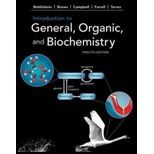
(a)
Interpretation:
If the given statement is true or false should be stated.
Concept Introduction:
The kinetic molecular theory state that particles of gas are always in constant motion and they show elastic collisions.
(b)
Interpretation:
If the given statement is true or false should be stated.
Concept Introduction:
The kinetic molecular theory state that particles of gas are always in constant motion and they show elastic collisions.
(c)
Interpretation:
If the given statement is true or false should be stated.
Concept Introduction:
The kinetic molecular theory state that particles of gas are always in constant motion and they show elastic collisions.
(d)
Interpretation:
If the given statement is true or false should be stated.
Concept Introduction:
The kinetic molecular theory state that particles of gas are always in constant motion and they show elastic collisions.
(e)
Interpretation:
If the given statement is true or false should be stated.
Concept Introduction:
The kinetic molecular theory state that particles of gas are always in constant motion and they show elastic collisions.
(f)
Interpretation:
If the given statement is true or false should be stated.
Concept Introduction:
The kinetic molecular theory state that particles of gas are always in constant motion and they show elastic collisions.
(g)
Interpretation:
If the given statement is true or false should be stated.
Concept Introduction:
The kinetic molecular theory state that particles of gas are always in constant motion and they show elastic collisions.
(h)
Interpretation:
If the given statement is true or false should be stated.
Concept Introduction:
The kinetic molecular theory state that particles of gas are always in constant motion and they show elastic collisions.
(i)
Interpretation:
If the given statement is true or false should be stated.
Concept Introduction:
The kinetic molecular theory state that particles of gas are always in constant motion and they show elastic collisions.
(j)
Interpretation:
If the given statement is true or false should be stated.
Concept Introduction:
The kinetic molecular theory state that particles of gas are always in constant motion and they show elastic collisions.
Trending nowThis is a popular solution!

Chapter 5 Solutions
Introduction To General, Organic, And Biochemistry
- Please predict the products for each of the following reactions: 1.03 2. H₂O NaNH, 1. n-BuLi 2. Mel A H₂ 10 9 0 H2SO4, H₂O HgSO4 Pd or Pt (catalyst) B 9 2 n-BuLi ♡ D2 (deuterium) Lindlar's Catalyst 1. NaNH2 2. EtBr Na, ND3 (deuterium) 2. H₂O2, NaOH 1. (Sia)2BH с Darrow_forwardin the scope of ontario SCH4U grade 12 course, please show ALL workarrow_forwardIs the chemical reaction CuCl42-(green) + 4H2O <==> Cu(H2O)42+(blue) + 4Cl- exothermic or endothermic?arrow_forward
- If we react tetraethoxypropane with hydrazine, what is the product obtained (explain its formula). State the reason why the corresponding dialdehyde is not used.arrow_forwarddrawing, no aiarrow_forwardIf CH3COCH2CH(OCH3)2 (4,4-dimethoxy-2-butanone) and hydrazine react, two isomeric products are formed. State their structure and which will be the majority.arrow_forward
- + Reset Provide the correct IUPAC name for the compound shown here. 4-methylhept-2-ene (Z)- (E)- 1-6-5-2-3-4- cyclo iso tert- sec- di tri hept hex oct meth eth pent ane yne ene ylarrow_forward+ Provide the correct IUPAC name for the compound shown here. Reset H3C H H C CH3 CH-CH3 1-3-methylpent ene trans- cis- 5-6-3-1-2-4- tert- tri sec- di cyclo iso but pent hex meth prop eth yl ane ene yne ☑arrow_forwarddrawing, no aiarrow_forward
 Introduction to General, Organic and BiochemistryChemistryISBN:9781285869759Author:Frederick A. Bettelheim, William H. Brown, Mary K. Campbell, Shawn O. Farrell, Omar TorresPublisher:Cengage Learning
Introduction to General, Organic and BiochemistryChemistryISBN:9781285869759Author:Frederick A. Bettelheim, William H. Brown, Mary K. Campbell, Shawn O. Farrell, Omar TorresPublisher:Cengage Learning Chemistry for Engineering StudentsChemistryISBN:9781337398909Author:Lawrence S. Brown, Tom HolmePublisher:Cengage Learning
Chemistry for Engineering StudentsChemistryISBN:9781337398909Author:Lawrence S. Brown, Tom HolmePublisher:Cengage Learning General Chemistry - Standalone book (MindTap Cour...ChemistryISBN:9781305580343Author:Steven D. Gammon, Ebbing, Darrell Ebbing, Steven D., Darrell; Gammon, Darrell Ebbing; Steven D. Gammon, Darrell D.; Gammon, Ebbing; Steven D. Gammon; DarrellPublisher:Cengage Learning
General Chemistry - Standalone book (MindTap Cour...ChemistryISBN:9781305580343Author:Steven D. Gammon, Ebbing, Darrell Ebbing, Steven D., Darrell; Gammon, Darrell Ebbing; Steven D. Gammon, Darrell D.; Gammon, Ebbing; Steven D. Gammon; DarrellPublisher:Cengage Learning Chemistry: The Molecular ScienceChemistryISBN:9781285199047Author:John W. Moore, Conrad L. StanitskiPublisher:Cengage Learning
Chemistry: The Molecular ScienceChemistryISBN:9781285199047Author:John W. Moore, Conrad L. StanitskiPublisher:Cengage Learning Living By Chemistry: First Edition TextbookChemistryISBN:9781559539418Author:Angelica StacyPublisher:MAC HIGHER
Living By Chemistry: First Edition TextbookChemistryISBN:9781559539418Author:Angelica StacyPublisher:MAC HIGHER Introductory Chemistry: A FoundationChemistryISBN:9781337399425Author:Steven S. Zumdahl, Donald J. DeCostePublisher:Cengage Learning
Introductory Chemistry: A FoundationChemistryISBN:9781337399425Author:Steven S. Zumdahl, Donald J. DeCostePublisher:Cengage Learning





